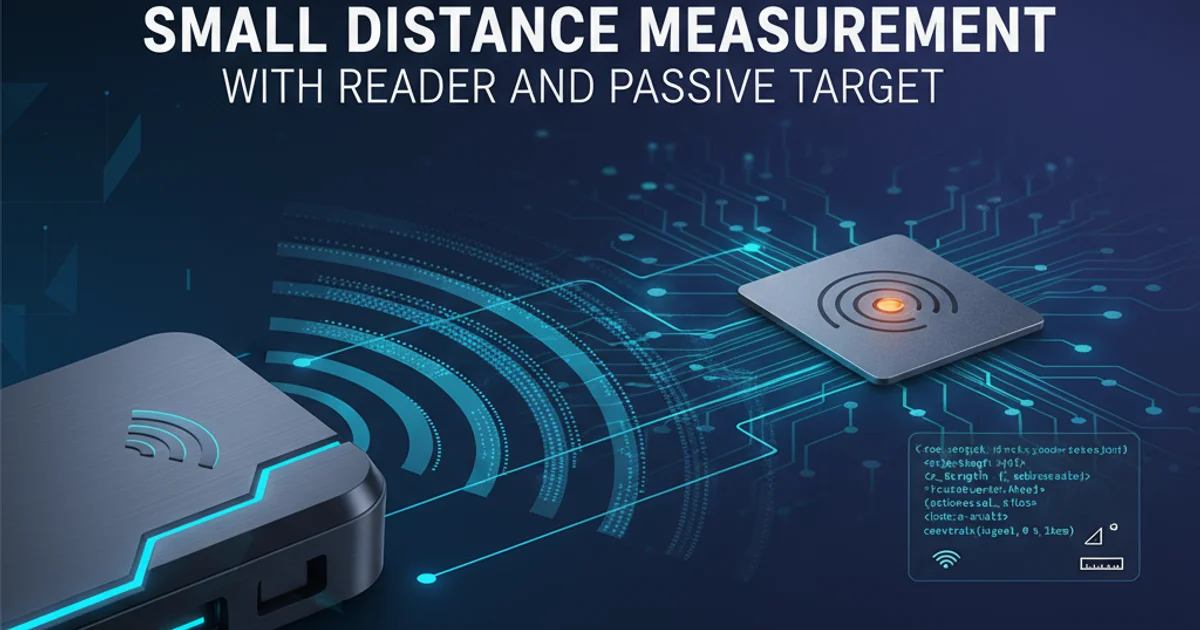Small Distance Measurement With Reader and Passive Target
Categories:
Achieving Sub-Centimeter Accuracy: Small Distance Measurement with RFID

Explore the challenges and solutions for precise small distance measurements using passive RFID tags and readers, focusing on applications requiring high accuracy.
Measuring small distances with high precision is a critical requirement in many industrial, medical, and consumer applications. While RFID is widely known for identification and tracking, its capabilities extend to distance sensing, particularly for short ranges. This article delves into the techniques and considerations for achieving sub-centimeter accuracy using passive RFID tags and readers, highlighting the underlying principles and practical implementations.
Understanding RFID for Distance Measurement
Traditional RFID systems are designed for presence detection and identification. However, by analyzing specific characteristics of the radio frequency signal, it's possible to infer distance. The primary methods for distance measurement with RFID include Received Signal Strength Indicator (RSSI), Phase Difference of Arrival (PDOA), and Time of Flight (ToF). For small distances and high accuracy, PDOA and advanced RSSI techniques are often preferred due to their sensitivity to subtle changes in the radio environment.
flowchart TD
A[RFID Reader] --> B{Transmit Signal}
B --> C[Passive RFID Tag]
C --> D{Reflect Signal}
D --> E[RFID Reader (Receive)]
E --> F{"Measure Signal Characteristics (RSSI, Phase)"}
F --> G[Calculate Distance]
G --> H[Output Small Distance]Basic RFID Distance Measurement Process
Passive RFID tags draw power from the reader's emitted RF field and reflect a modulated signal back. The properties of this reflected signal, such as its strength and phase, change predictably with the distance between the reader and the tag. By carefully calibrating the system and employing sophisticated signal processing algorithms, these changes can be translated into precise distance measurements.
Key Factors for High Accuracy
Achieving sub-centimeter accuracy with RFID is challenging and depends on several critical factors:
- Antenna Design and Placement: The reader and tag antenna designs significantly impact signal propagation and measurement accuracy. Directional antennas can improve spatial resolution, while careful placement minimizes multipath interference.
- Frequency Band: Higher frequencies (e.g., UHF 860-960 MHz) generally offer better resolution for phase-based measurements due to shorter wavelengths, but are also more susceptible to environmental factors.
- Environmental Stability: Multipath reflections from nearby objects (walls, metal surfaces) can severely degrade accuracy. Controlling the environment or employing advanced signal processing to mitigate multipath effects is crucial.
- Calibration: Regular and precise calibration of the system is essential to establish a reliable relationship between signal characteristics and actual distance.
- Signal Processing Algorithms: Advanced algorithms, including Kalman filters, particle filters, and machine learning techniques, can enhance accuracy by filtering noise, compensating for environmental variations, and improving the interpretation of raw signal data.
Practical Implementation Considerations
When implementing a small distance RFID measurement system, developers must address several practical aspects:
- Reader Configuration: Configure the reader's power output, read rate, and antenna settings to optimize signal quality for the specific measurement range.
- Tag Selection: Choose tags with consistent RF characteristics across the desired operating range. Custom tag designs might be necessary for highly specialized applications.
- Data Acquisition: Implement a robust data acquisition system to capture raw RSSI and phase data at a high sampling rate.
- Software Development: Develop custom software to process the raw data, apply calibration curves, and execute distance calculation algorithms. This often involves integrating with the reader's SDK.
- Testing and Validation: Thoroughly test the system in the target environment under various conditions to validate accuracy and repeatability.
import numpy as np
def calculate_distance_from_phase(phase_angle_rad, frequency_hz):
# Speed of light in vacuum (m/s)
c = 299792458
# Wavelength (m)
wavelength = c / frequency_hz
# Distance calculation based on phase difference (half-wavelength ambiguity)
# This is a simplified model; real-world requires more complex algorithms
distance = (phase_angle_rad / (2 * np.pi)) * (wavelength / 2)
return distance
# Example usage (hypothetical values)
reader_frequency = 915e6 # 915 MHz
measured_phase_rad = np.pi / 4 # 45 degrees
distance_m = calculate_distance_from_phase(measured_phase_rad, reader_frequency)
print(f"Calculated distance: {distance_m * 100:.2f} cm")
Simplified Python example for distance calculation using phase difference. Note: This is a conceptual example; real-world implementations are more complex.